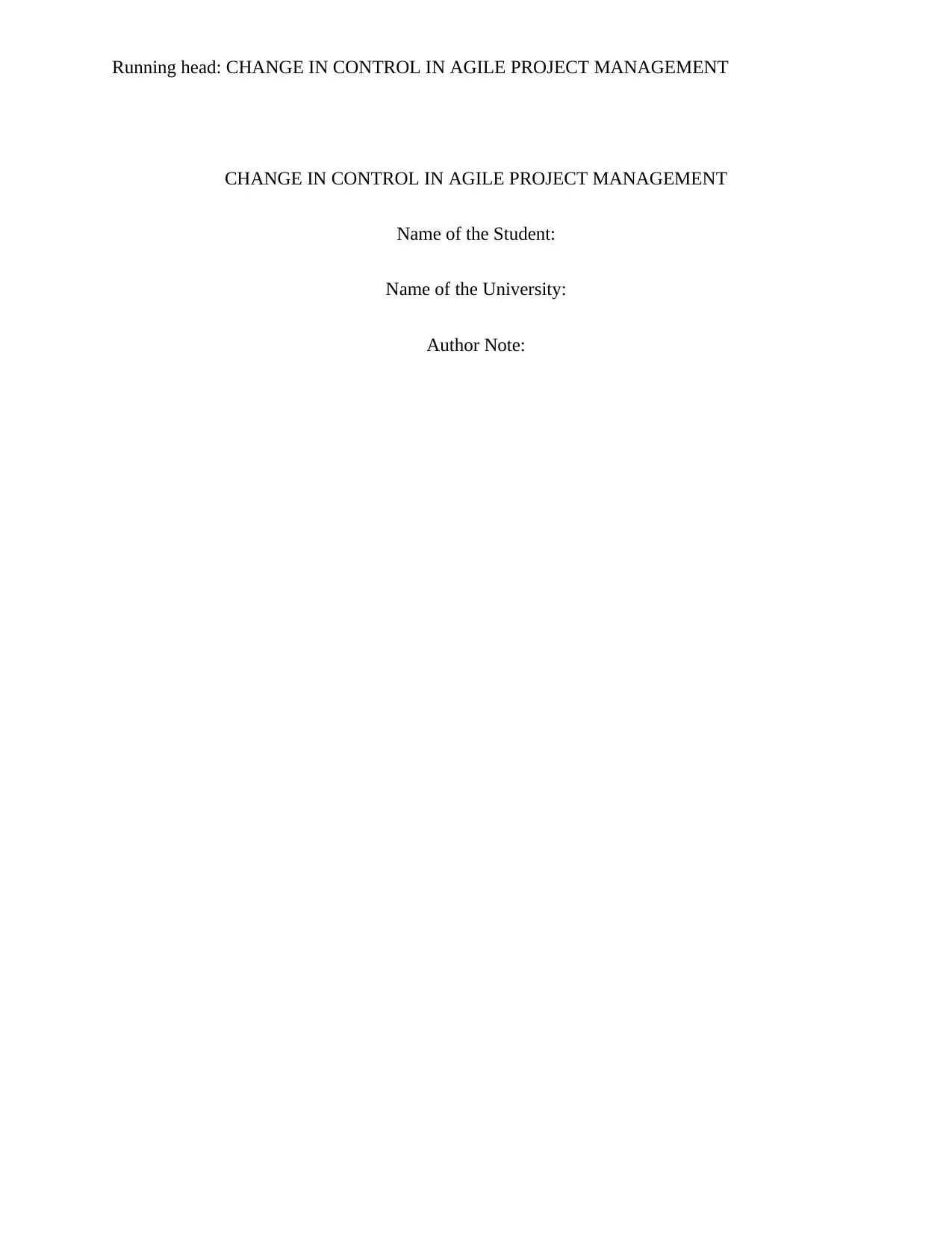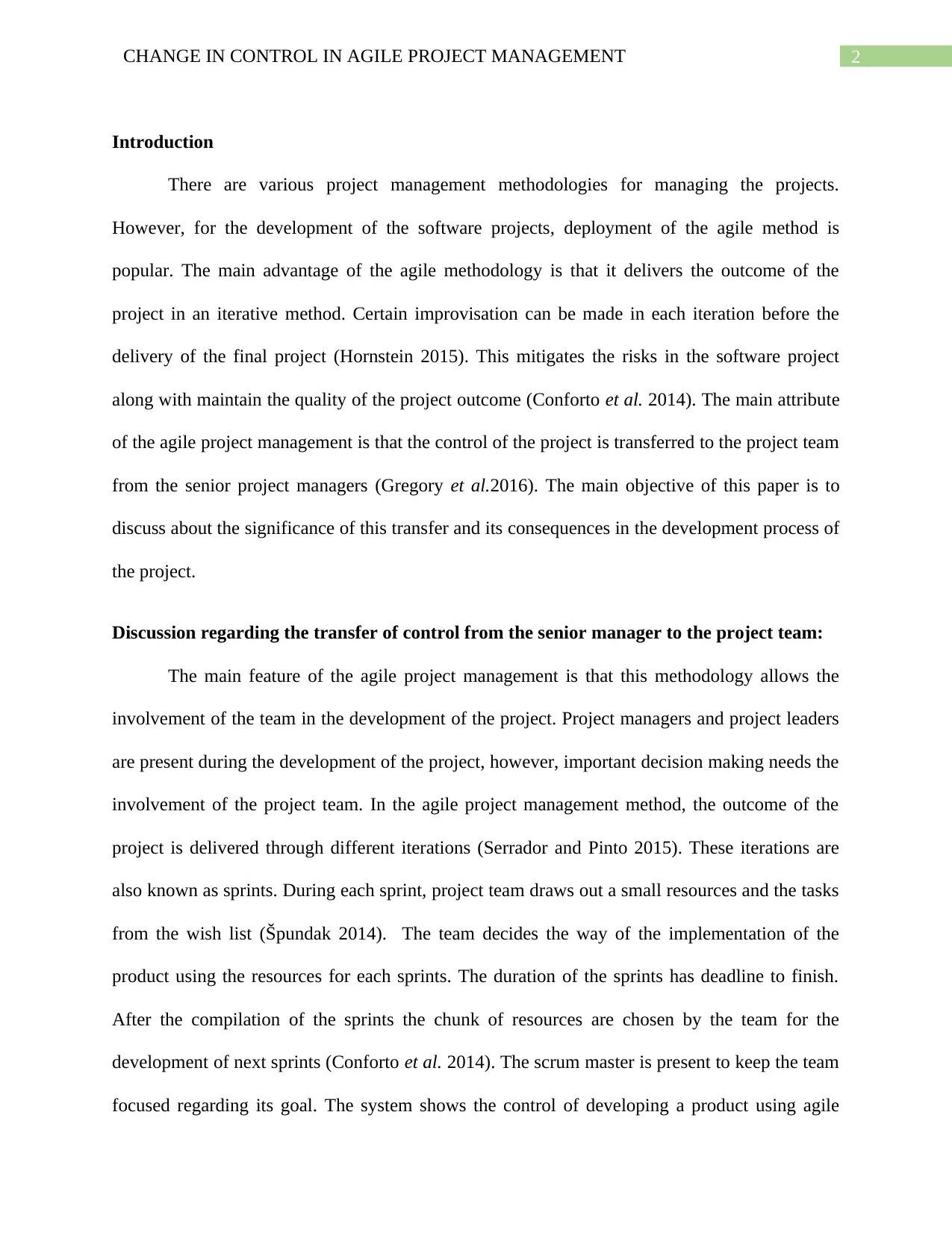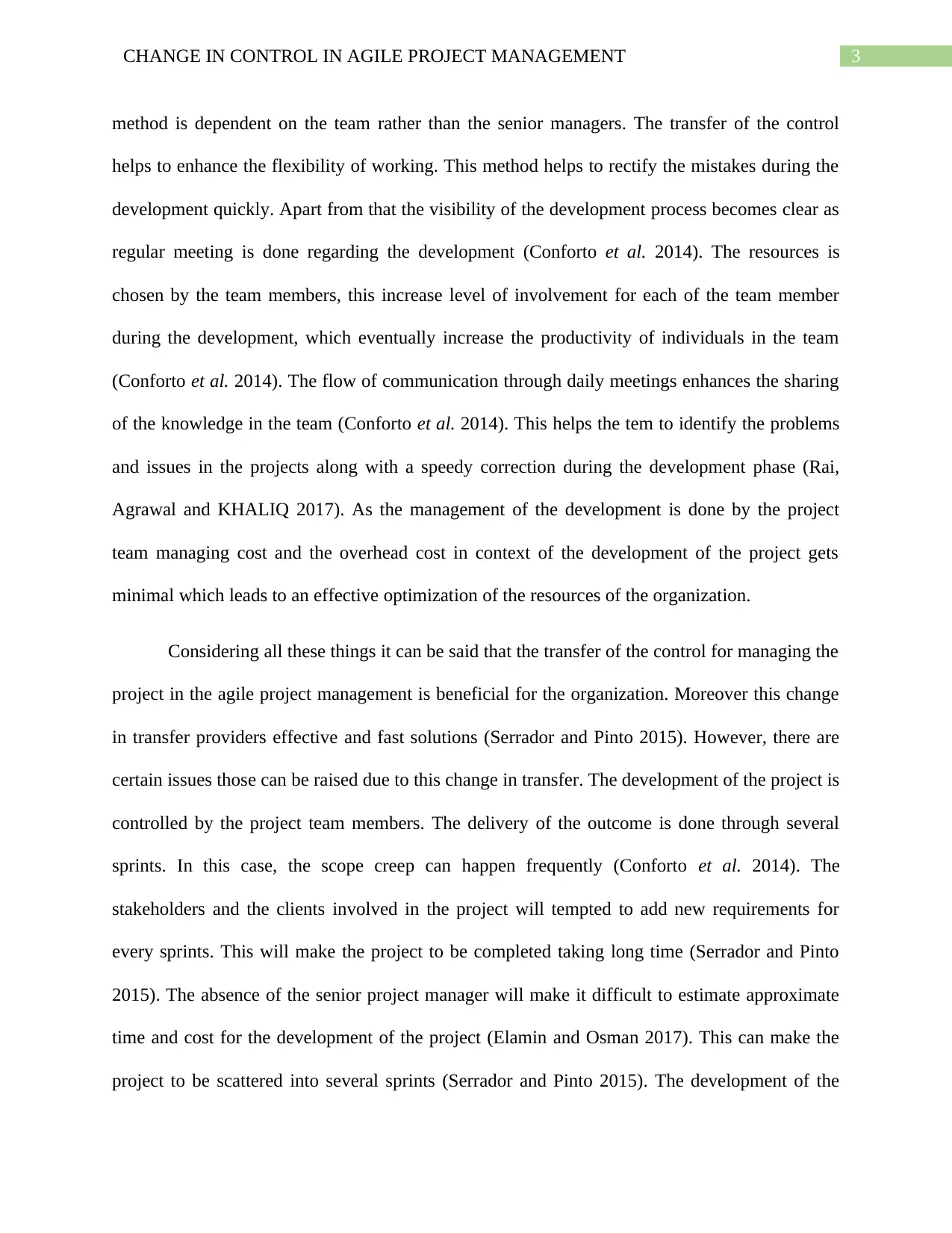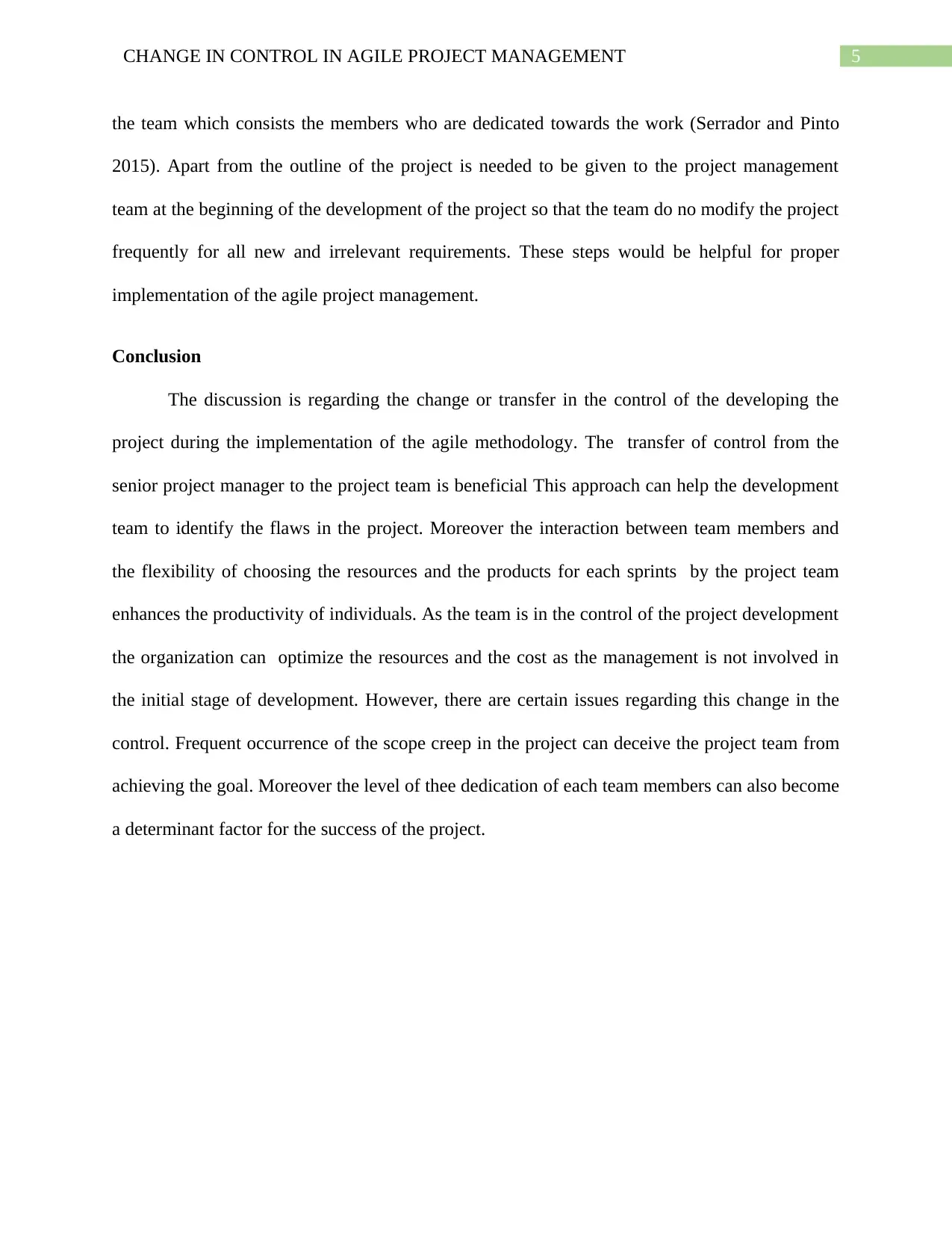IMAT5205: Agile Project Management - Change in Control Analysis
VerifiedAdded on 2023/05/30
|8
|1854
|267
Essay
AI Summary
This essay discusses the transfer of control from senior managers to project teams within agile project management, highlighting the significance and consequences of this shift. Agile methodology emphasizes iterative development, team involvement, and flexibility. The transfer of control enhances flexibility, visibility, and team productivity, optimizing resource allocation and communication. However, it also presents challenges such as scope creep, difficulty in estimating time and cost, and reliance on team member commitment. The effectiveness of this change hinges on dedicated team members, proper resource allocation, and adherence to timelines, with the scrum master playing a crucial role in guiding the team. The essay concludes that agile project management is effective if change control is managed properly, emphasizing the need for dedicated teams and a clear project outline to avoid frequent modifications.

Running head: CHANGE IN CONTROL IN AGILE PROJECT MANAGEMENT
CHANGE IN CONTROL IN AGILE PROJECT MANAGEMENT
Name of the Student:
Name of the University:
Author Note:
CHANGE IN CONTROL IN AGILE PROJECT MANAGEMENT
Name of the Student:
Name of the University:
Author Note:
Paraphrase This Document
Need a fresh take? Get an instant paraphrase of this document with our AI Paraphraser

1CHANGE IN CONTROL IN AGILE PROJECT MANAGEMENT
Table of Contents
Introduction......................................................................................................................................2
Discussion regarding the transfer of control from the senior manager to the project team:...........2
Determining the effectiveness of the change of control in agile method:.......................................4
Conclusion.......................................................................................................................................5
References........................................................................................................................................5
Table of Contents
Introduction......................................................................................................................................2
Discussion regarding the transfer of control from the senior manager to the project team:...........2
Determining the effectiveness of the change of control in agile method:.......................................4
Conclusion.......................................................................................................................................5
References........................................................................................................................................5

2CHANGE IN CONTROL IN AGILE PROJECT MANAGEMENT
Introduction
There are various project management methodologies for managing the projects.
However, for the development of the software projects, deployment of the agile method is
popular. The main advantage of the agile methodology is that it delivers the outcome of the
project in an iterative method. Certain improvisation can be made in each iteration before the
delivery of the final project (Hornstein 2015). This mitigates the risks in the software project
along with maintain the quality of the project outcome (Conforto et al. 2014). The main attribute
of the agile project management is that the control of the project is transferred to the project team
from the senior project managers (Gregory et al.2016). The main objective of this paper is to
discuss about the significance of this transfer and its consequences in the development process of
the project.
Discussion regarding the transfer of control from the senior manager to the project team:
The main feature of the agile project management is that this methodology allows the
involvement of the team in the development of the project. Project managers and project leaders
are present during the development of the project, however, important decision making needs the
involvement of the project team. In the agile project management method, the outcome of the
project is delivered through different iterations (Serrador and Pinto 2015). These iterations are
also known as sprints. During each sprint, project team draws out a small resources and the tasks
from the wish list (Špundak 2014). The team decides the way of the implementation of the
product using the resources for each sprints. The duration of the sprints has deadline to finish.
After the compilation of the sprints the chunk of resources are chosen by the team for the
development of next sprints (Conforto et al. 2014). The scrum master is present to keep the team
focused regarding its goal. The system shows the control of developing a product using agile
Introduction
There are various project management methodologies for managing the projects.
However, for the development of the software projects, deployment of the agile method is
popular. The main advantage of the agile methodology is that it delivers the outcome of the
project in an iterative method. Certain improvisation can be made in each iteration before the
delivery of the final project (Hornstein 2015). This mitigates the risks in the software project
along with maintain the quality of the project outcome (Conforto et al. 2014). The main attribute
of the agile project management is that the control of the project is transferred to the project team
from the senior project managers (Gregory et al.2016). The main objective of this paper is to
discuss about the significance of this transfer and its consequences in the development process of
the project.
Discussion regarding the transfer of control from the senior manager to the project team:
The main feature of the agile project management is that this methodology allows the
involvement of the team in the development of the project. Project managers and project leaders
are present during the development of the project, however, important decision making needs the
involvement of the project team. In the agile project management method, the outcome of the
project is delivered through different iterations (Serrador and Pinto 2015). These iterations are
also known as sprints. During each sprint, project team draws out a small resources and the tasks
from the wish list (Špundak 2014). The team decides the way of the implementation of the
product using the resources for each sprints. The duration of the sprints has deadline to finish.
After the compilation of the sprints the chunk of resources are chosen by the team for the
development of next sprints (Conforto et al. 2014). The scrum master is present to keep the team
focused regarding its goal. The system shows the control of developing a product using agile
⊘ This is a preview!⊘
Do you want full access?
Subscribe today to unlock all pages.

Trusted by 1+ million students worldwide

3CHANGE IN CONTROL IN AGILE PROJECT MANAGEMENT
method is dependent on the team rather than the senior managers. The transfer of the control
helps to enhance the flexibility of working. This method helps to rectify the mistakes during the
development quickly. Apart from that the visibility of the development process becomes clear as
regular meeting is done regarding the development (Conforto et al. 2014). The resources is
chosen by the team members, this increase level of involvement for each of the team member
during the development, which eventually increase the productivity of individuals in the team
(Conforto et al. 2014). The flow of communication through daily meetings enhances the sharing
of the knowledge in the team (Conforto et al. 2014). This helps the tem to identify the problems
and issues in the projects along with a speedy correction during the development phase (Rai,
Agrawal and KHALIQ 2017). As the management of the development is done by the project
team managing cost and the overhead cost in context of the development of the project gets
minimal which leads to an effective optimization of the resources of the organization.
Considering all these things it can be said that the transfer of the control for managing the
project in the agile project management is beneficial for the organization. Moreover this change
in transfer providers effective and fast solutions (Serrador and Pinto 2015). However, there are
certain issues those can be raised due to this change in transfer. The development of the project is
controlled by the project team members. The delivery of the outcome is done through several
sprints. In this case, the scope creep can happen frequently (Conforto et al. 2014). The
stakeholders and the clients involved in the project will tempted to add new requirements for
every sprints. This will make the project to be completed taking long time (Serrador and Pinto
2015). The absence of the senior project manager will make it difficult to estimate approximate
time and cost for the development of the project (Elamin and Osman 2017). This can make the
project to be scattered into several sprints (Serrador and Pinto 2015). The development of the
method is dependent on the team rather than the senior managers. The transfer of the control
helps to enhance the flexibility of working. This method helps to rectify the mistakes during the
development quickly. Apart from that the visibility of the development process becomes clear as
regular meeting is done regarding the development (Conforto et al. 2014). The resources is
chosen by the team members, this increase level of involvement for each of the team member
during the development, which eventually increase the productivity of individuals in the team
(Conforto et al. 2014). The flow of communication through daily meetings enhances the sharing
of the knowledge in the team (Conforto et al. 2014). This helps the tem to identify the problems
and issues in the projects along with a speedy correction during the development phase (Rai,
Agrawal and KHALIQ 2017). As the management of the development is done by the project
team managing cost and the overhead cost in context of the development of the project gets
minimal which leads to an effective optimization of the resources of the organization.
Considering all these things it can be said that the transfer of the control for managing the
project in the agile project management is beneficial for the organization. Moreover this change
in transfer providers effective and fast solutions (Serrador and Pinto 2015). However, there are
certain issues those can be raised due to this change in transfer. The development of the project is
controlled by the project team members. The delivery of the outcome is done through several
sprints. In this case, the scope creep can happen frequently (Conforto et al. 2014). The
stakeholders and the clients involved in the project will tempted to add new requirements for
every sprints. This will make the project to be completed taking long time (Serrador and Pinto
2015). The absence of the senior project manager will make it difficult to estimate approximate
time and cost for the development of the project (Elamin and Osman 2017). This can make the
project to be scattered into several sprints (Serrador and Pinto 2015). The development of the
Paraphrase This Document
Need a fresh take? Get an instant paraphrase of this document with our AI Paraphraser

4CHANGE IN CONTROL IN AGILE PROJECT MANAGEMENT
project is dependent on the team members of the project. In this case, if the members of the team
are not committed enough towards the work the failure of the project may happen. Scrum master
is present for leading the team towards its goal (Serrador and Pinto 2015). Sometimes it has been
seen that strict control of the scrum master over the team is causing the distraction for the team
members for developing the project. In this case the project may not deliver the required
outcome.
Determining the effectiveness of the change of control in agile method:
Agile method is proved to be beneficial for the development of the software projects.
There are different variations of agile project management. Some of the variations like DSDM
often used in the construction projects. Mainly, agile methods are useful for the development of
the software. There are certain benefits of controlling the project through the project team in
agile methods (Serrador and Pinto 2015). Those can be beneficial for improving the quality of
the final outcome of the product. However, there are issues those can be happened as the senior
manager is not in the charge of control in agile project management (Serrador and Pinto 2015).
In this context the frequent changes in the requirements and the way of the implementation can
causes the uncertainty in the development process (Conforto et al. 2014). A successful
management of the project depends on the dedication of the team members and proper
allocation of the resources along with maintain the timeline for each tasks (Baumann et al.
2015). In this case, change in control of the project in agile method can create unavoidable
issues. Evaluating both advantages and the issues regarding the change in the control of the
project. It can be said that agile project management can be effective and efficient only if the
change in the control can be managed by the project management team is managed in a proper
way(Serrador and Pinto 2015). In this case, it is the responsibility of the scrum master to develop
project is dependent on the team members of the project. In this case, if the members of the team
are not committed enough towards the work the failure of the project may happen. Scrum master
is present for leading the team towards its goal (Serrador and Pinto 2015). Sometimes it has been
seen that strict control of the scrum master over the team is causing the distraction for the team
members for developing the project. In this case the project may not deliver the required
outcome.
Determining the effectiveness of the change of control in agile method:
Agile method is proved to be beneficial for the development of the software projects.
There are different variations of agile project management. Some of the variations like DSDM
often used in the construction projects. Mainly, agile methods are useful for the development of
the software. There are certain benefits of controlling the project through the project team in
agile methods (Serrador and Pinto 2015). Those can be beneficial for improving the quality of
the final outcome of the product. However, there are issues those can be happened as the senior
manager is not in the charge of control in agile project management (Serrador and Pinto 2015).
In this context the frequent changes in the requirements and the way of the implementation can
causes the uncertainty in the development process (Conforto et al. 2014). A successful
management of the project depends on the dedication of the team members and proper
allocation of the resources along with maintain the timeline for each tasks (Baumann et al.
2015). In this case, change in control of the project in agile method can create unavoidable
issues. Evaluating both advantages and the issues regarding the change in the control of the
project. It can be said that agile project management can be effective and efficient only if the
change in the control can be managed by the project management team is managed in a proper
way(Serrador and Pinto 2015). In this case, it is the responsibility of the scrum master to develop

5CHANGE IN CONTROL IN AGILE PROJECT MANAGEMENT
the team which consists the members who are dedicated towards the work (Serrador and Pinto
2015). Apart from the outline of the project is needed to be given to the project management
team at the beginning of the development of the project so that the team do no modify the project
frequently for all new and irrelevant requirements. These steps would be helpful for proper
implementation of the agile project management.
Conclusion
The discussion is regarding the change or transfer in the control of the developing the
project during the implementation of the agile methodology. The transfer of control from the
senior project manager to the project team is beneficial This approach can help the development
team to identify the flaws in the project. Moreover the interaction between team members and
the flexibility of choosing the resources and the products for each sprints by the project team
enhances the productivity of individuals. As the team is in the control of the project development
the organization can optimize the resources and the cost as the management is not involved in
the initial stage of development. However, there are certain issues regarding this change in the
control. Frequent occurrence of the scope creep in the project can deceive the project team from
achieving the goal. Moreover the level of thee dedication of each team members can also become
a determinant factor for the success of the project.
the team which consists the members who are dedicated towards the work (Serrador and Pinto
2015). Apart from the outline of the project is needed to be given to the project management
team at the beginning of the development of the project so that the team do no modify the project
frequently for all new and irrelevant requirements. These steps would be helpful for proper
implementation of the agile project management.
Conclusion
The discussion is regarding the change or transfer in the control of the developing the
project during the implementation of the agile methodology. The transfer of control from the
senior project manager to the project team is beneficial This approach can help the development
team to identify the flaws in the project. Moreover the interaction between team members and
the flexibility of choosing the resources and the products for each sprints by the project team
enhances the productivity of individuals. As the team is in the control of the project development
the organization can optimize the resources and the cost as the management is not involved in
the initial stage of development. However, there are certain issues regarding this change in the
control. Frequent occurrence of the scope creep in the project can deceive the project team from
achieving the goal. Moreover the level of thee dedication of each team members can also become
a determinant factor for the success of the project.
⊘ This is a preview!⊘
Do you want full access?
Subscribe today to unlock all pages.

Trusted by 1+ million students worldwide

6CHANGE IN CONTROL IN AGILE PROJECT MANAGEMENT
References
Baumann, T., Harfst, S., Swanger, A., Bayer, D., Cell, A. and Boswell, W., 2015. Managing
successful project teams in a diverse stakeholder environment: Merging industry best practices
with an education system to address critical human factors. Procedia-Social and Behavioral
Sciences, 194, pp.20-32.
Conforto, E.C., Salum, F., Amaral, D.C., da Silva, S.L. and de Almeida, L.F.M., 2014. Can agile
project management be adopted by industries other than software development?. Project
Management Journal, 45(3), pp.21-34.
Elamin, R. and Osman, R., 2017, July. Towards Requirements Reuse by Implementing
Traceability in Agile Development. In Computer Software and Applications Conference
(COMPSAC), 2017 IEEE 41st Annual (Vol. 2, pp. 431-436). IEEE.
Gregory, P., Barroca, L., Sharp, H., Deshpande, A. and Taylor, K., 2016. The challenges that
challenge: Engaging with agile practitioners’ concerns. Information and Software
Technology, 77, pp.92-104.
Hornstein, H.A., 2015. The integration of project management and organizational change
management is now a necessity. International Journal of Project Management, 33(2), pp.291-
298.
Rai, A.K., Agrawal, S. and KHALIQ, E., 2017. Identification of Agile Software Risk Indicators
and Evaluation of Agile Software Development Project Risk Occurrence
Probability. International Journal of Engineering Technology, Management and Applied
Sciences, 5(7), pp.403-408.
References
Baumann, T., Harfst, S., Swanger, A., Bayer, D., Cell, A. and Boswell, W., 2015. Managing
successful project teams in a diverse stakeholder environment: Merging industry best practices
with an education system to address critical human factors. Procedia-Social and Behavioral
Sciences, 194, pp.20-32.
Conforto, E.C., Salum, F., Amaral, D.C., da Silva, S.L. and de Almeida, L.F.M., 2014. Can agile
project management be adopted by industries other than software development?. Project
Management Journal, 45(3), pp.21-34.
Elamin, R. and Osman, R., 2017, July. Towards Requirements Reuse by Implementing
Traceability in Agile Development. In Computer Software and Applications Conference
(COMPSAC), 2017 IEEE 41st Annual (Vol. 2, pp. 431-436). IEEE.
Gregory, P., Barroca, L., Sharp, H., Deshpande, A. and Taylor, K., 2016. The challenges that
challenge: Engaging with agile practitioners’ concerns. Information and Software
Technology, 77, pp.92-104.
Hornstein, H.A., 2015. The integration of project management and organizational change
management is now a necessity. International Journal of Project Management, 33(2), pp.291-
298.
Rai, A.K., Agrawal, S. and KHALIQ, E., 2017. Identification of Agile Software Risk Indicators
and Evaluation of Agile Software Development Project Risk Occurrence
Probability. International Journal of Engineering Technology, Management and Applied
Sciences, 5(7), pp.403-408.
Paraphrase This Document
Need a fresh take? Get an instant paraphrase of this document with our AI Paraphraser

7CHANGE IN CONTROL IN AGILE PROJECT MANAGEMENT
Serrador, P. and Pinto, J.K., 2015. Does Agile work?—A quantitative analysis of agile project
success. International Journal of Project Management, 33(5), pp.1040-1051.
Špundak, M., 2014. Mixed agile/traditional project management methodology–reality or
illusion?. Procedia-Social and Behavioral Sciences, 119, pp.939-948.
Serrador, P. and Pinto, J.K., 2015. Does Agile work?—A quantitative analysis of agile project
success. International Journal of Project Management, 33(5), pp.1040-1051.
Špundak, M., 2014. Mixed agile/traditional project management methodology–reality or
illusion?. Procedia-Social and Behavioral Sciences, 119, pp.939-948.
1 out of 8
Related Documents
Your All-in-One AI-Powered Toolkit for Academic Success.
+13062052269
info@desklib.com
Available 24*7 on WhatsApp / Email
![[object Object]](/_next/static/media/star-bottom.7253800d.svg)
Unlock your academic potential
Copyright © 2020–2025 A2Z Services. All Rights Reserved. Developed and managed by ZUCOL.





